In Volume VI of The Life and Adventures of Tristram Shandy, Gentleman, Laurence Sterne leaves page 147 entirely blank, in order that readers should create for themselves an image in their minds: ‘as like your mistress as you can——as unlike your wife as your conscience will let you’. In 2016, the Laurence Sterne Trust commissioned 147 writers and artists to put their imaginings onto the page, in whatever material form they might choose. The resulting works were exhibited at Shandy Hall, toured to further venues, and auctioned online. In this paper, two of the writers involved consider the importance of Sterne’s original gesture and its ongoing relevance in a digital age, with its emphasis on interactivity. The paper explores how various artists grappled with the complex issues of making manifest their reactions to Sterne’s invitation. It builds on papers relating to two previous Shandy Hall projects interpreting Sterne’s visual gestures within his text: ‘The Black Page’ and ‘Emblem of My Work’.
Keywords: Tristram Shandy — blank page — mind — paint — interactivity
1. Introduction
‘Paint her to your own mind’ is the third in a series of projects initiated by the Laurence Sterne Trust, based at Shandy Hall, North Yorkshire, where Laurence Sterne lived and worked during the eighteenth century. Each of the three projects celebrates a notable visual intervention made by Sterne in his novel The Life and Opinions of Tristram Shandy, Gentleman (1767). The first, ‘The Black Page’, commissioned 73 writers and artists to interpret the black page that appears on page 73 of volume I, following the words ‘Alas poor Yorick’. The second, ‘Emblem of My Work’, interpreted the marbling that appears on page 169 of volume III, and which Sterne calls the ‘motly emblem’ of his work: colourful, playful, incorporating an element of chance, and unique to each printing of the book, thereby indicating a unique relationship between the author and each reader.
The third project interprets page 147 of volume VI, which Sterne leaves blank, in order that readers should conjure an image for themselves. The words that precede it form an instruction:
To conceive this right,—call for pen and ink—here’s paper ready to your hand.——Sit down, Sir, paint her to your own mind——as like your mistress as you can——as unlike your wife as your conscience will let you—’tis all one to me——please but your own fancy in it.

For the project Patrick Wildgust, Curator at Shandy Hall, provided instructions of his own to those commissioned (many of whom had worked on the previous two projects):
There, ready and waiting, is the blank page for you to ‘paint’ her. Sterne’s clever phrasing makes the suggestion ambiguous—you can imagine her (paint her to your own mind, to your imagination) or you can actually make the image of her (paint her the way you think she should be depicted). And this can be any way you wish—in words, collage, musical notation, oil, poetry, photography, watercolour … the page is your oyster. (Laurence Sterne Trust 2016, n.pag.)
As with the two previous projects, the works produced were exhibited — anonymously. An exhibition at Shandy Hall ran from 9 July to 30 September 2016, after which it moved to the Constantine Gallery, Teesside University (7 to 23 October), and on to &Model Gallery, Leeds (28 October to 12 November). During this time the works gradually appeared online, on a blog page linked to the Laurence Sterne Trust website. Each anonymous work was offered for sale, by auction, with bids starting at £50. Bidding closed on 16 November 2016, with many works sold, some for several hundred pounds — the money going to the Laurence Sterne Trust for ongoing upkeep of the house and further projects.
For the viewer, and the potential purchaser, the anonymity was a compelling part of the project. Although all the works were unattributed, a full list of participating artists was made public.1 As a result, there was an inevitable guessing game (which the Emblem project turned into a formal challenge, a prize going to the person matching the highest number of artists and works). Some artists have recognisable styles — and many viewers would have immediately recognised the work of Tom Gauld, Brian Dettmer, Carry Akroyd, John Baldessari, Graham Rawle and Carolyn Thompson — but others were not easily identifiable. There were perhaps fewer popular names than had been featured in the previous projects, although Stephen Fry was a notable addition. The possibility of acquiring a work by Fry, potentially for a minimal cost, was undoubtedly an attraction.
In a previous project, the work of a Turner Prize-winning artist, effectively available for £50, remained unsold, presumably unidentified by anyone. An intriguing aspect of all the projects is the way that some writers and artists have stepped out of their own immediate field of practice in following what is, after all, an unusual brief. Yes, some poets wrote poems, and print-makers and wood-engravers typically stuck with their trusted skills (especially true of the Emblem project), but others sidestepped their more habitual practice, taking their cue from Sterne’s own extra-textual interventions (see Munden 2016); their responses were experimental and, sometimes playfully, conceptual.

In his comments on the project blog, Geoffrey Day points out that Tristram Shandy ‘is, among many other things, a work about conception’ (Day 2016). Physical conception in the womb is the focus of the opening chapter, and the closing passage of the final volume (which may or may not have been intended as the end, since Sterne’s failing health prevented any further work) contains news about a cow, somewhat appropriately failing to conceive. As Day expresses it, ‘The notion of conception, both literal and figurative, is repeated throughout the book’:
Sterne frequently uses the image of conception to describe his position vis-a-vis his reader, most notably in a lament upon the short-comings of words which can ‘darken your hypothesis by placing a number of tall, opake words, one before another, in a right line, betwixt your own and your reader’s conception’.
It is interesting how, among other things, the expected orderliness of words appears to bother Sterne. This is one explanation for his inclination to disrupt the expected flow of his text in a variety of ways, with dashes, asterisks, the black and marbled pages, a swirling line when depicting a character twirling his stick when lost for words, and lines reflecting on the progress of his plot — which is also in constant rebellion against conventional narrative expectation. When Sterne’s literary heirs are mentioned, the list is mostly of novelists, such as Joyce, Woolf, Pynchon, Calvino, but Sterne — perhaps more than any of those novelists indebted to his invention — veers towards conceptual art. And his concern with typographical space might actually be considered more typical of a poet than a novelist. At the same time, he treats writing — its communicative and interactive qualities — as a social business, stressing the need to leave space for response:
Writing, when properly managed, (as you may be sure I think mine is) is but a different name for conversation. As no one, who knows what he is about in good company, would venture to talk all; — so no author, who understands the just boundaries of decorum and good breeding, would presume to think all: the truest respect which you can pay to the reader’s understanding, is to halve this matter amicably, and leave him something to imagine, in his turn, as well as yourself. (TS Vol II Chap III)
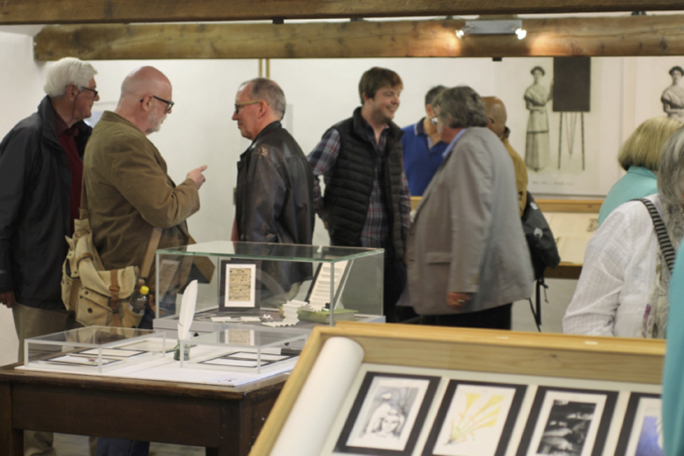
2. A dual challenge
Sterne’s blank page urges every reader towards an active, imaginative contribution to the work. How, though, were contemporary artists to give such imaginings form? As with the other ‘page’ projects,2 this one presented a dual challenge. Indeed, it seemed almost a contradiction in terms — interpreting what was ‘blank’ while making manifest an idea of ‘your own fancy’ — as Sterne has it, or beauty, as some project participants interpreted it (and the length of time elapsing between the first two projects and the third suggests that the Trust may have had some reservations about its viability).
A poem by Paul Munden, written later in response to the project as a whole, captures the essential contradiction at the heart of the project brief, and some of the responses, notably work #122.
Page 147
Paint her to your own mind —
a simultaneous demand
for secrecy and the broad,
daylight gestures of rejoice,
a love letter in invisible ink,
not knowing who will look
through ultraviolet eyes
and understand
or shrug their shoulders
and choose instead
to rub a coloured
crayon over the indented
contours of the page to crack
this childlike code. (Munden 2017: 106)
Work #122 depicts in words an elusive female character (or rather, and appropriately, her absence). Even the words are in a sense absent, not printed in the manner we usually expect of text (‘Hear hear’, Sterne might say):
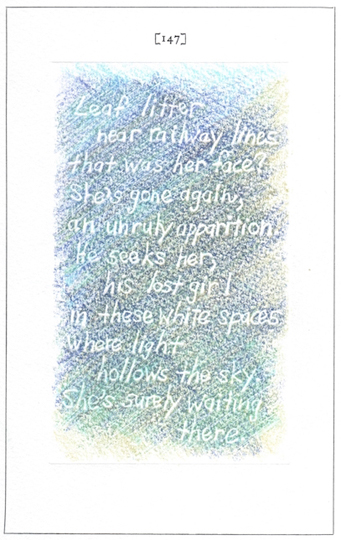
This work makes reference to some of the contradictions inherent in Sterne’s ‘brief’ for his blank page. In particular, it plays with notions of presence and absence, as its short poem is revealed as an indent in the paper rather than a positive inscription; a remnant of a previous act of writing. The poem is only revealed when rubbed with coloured pencils — or, as Munden’s poem has it, ‘crayons’. According to the poem’s speaker, the ‘lost girl’ is ‘surely waiting there’, but this creates a further sense of ambiguity and relativity because the location ‘there’ may be understood in a number of ways — as the blank page itself; as the poem’s setting near ‘railway lines’; as the novel Tristram Shandy; or as some alternative and unspecified location.
The image created by the pencils adds a further uncertainty. In a literal sense, this image is the rubbing that reveals the hitherto unseen words on the paper. However, it may also be interpreted as a vision of light ‘hollow[ing] the sky’, or an evocation of the leaf litter the poem mentions — or as something else entirely. In such ways, this work is constructed as a small homage to significant aspects of Laurence Sterne’s larger vision in Tristram Shandy — in which so many perspectives are problematised, the capacity of language to convey clear meaning is quizzed and questioned, and the reader is repeatedly asked to play an active part in making sense of the work — being part of an implicit agreement, as Sterne says, to ‘halve this matter amicably’.
The materiality of work #122 is part of its appeal. The colour is layered, so that we see the strokes of individual colour and the richer colour produced by the combination of layers (which makes a nod to the layering of the marbled page). It is this materiality that articulates the poem with increasing clarity, while also of course reflecting Sterne's own side-stepping from one art to another. As Munden and Dobrijevich have commented, Sterne’s ‘interventions’ are more than ‘cleverness’:
there is struggle, even failure to proceed any further without recourse to other artistic tools — an acknowledgement that one’s mastery of one particular medium is not enough, that the medium itself is not enough. It is a sort of restlessless, a recognition that an artist of any variety is using an imperfect toolkit (and, even in the case of the greatest artists, an imperfect skillset). It is perhaps when we see an artist acknowledge this, and reach for something else, something other, that we see artistic thought at its most inventive and incisive. (Munden & Dobrijevich 2018)
Another work that grapples with the idea of blankness, and without words at all, is work #71. This playfully reveals the shape of a nude woman outlined by the contours of an inlet and rocks — and thus the work may simultaneously be viewed in at least two ways. The implication is that Sterne’s suggested image partly inheres in the blank page from the novel (the part that is described by the body of water) and is partly a construct of the artist (the area of rocks that constitute the woman’s legs). This image may also reference the contemporary debate about problematic representations of women in contemporary culture, questioning viewers’ understandings about and interpretations of such work. In such a light, the figure’s partial blankness poses questions about the nature of many such representations, including the negation of individual identity that they so often involve.
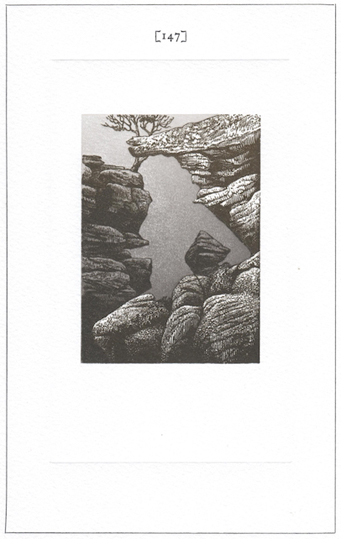
Work #87, while not explicitly invoking the idea of ‘blank page’, also allows a female figure to be both ‘hidden’ and ‘read’ within a landscape. Interestingly, the artist, in her accompanying information3 (and yes, this particular artist has an unmistakable style), is self-deprecating, referring to the work as ‘a bit of a cliché’, perhaps alluding to the idea of a supine Mother Nature that the image (playfully) invokes. However, this nuanced work goes beyond such an assessment in questioning what it is we see, and how we see it (and, interestingly, some viewers have trouble finding the figure within it).
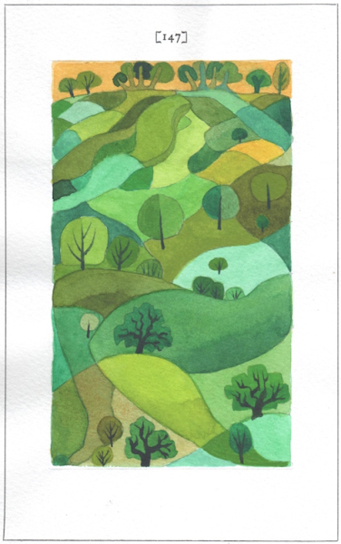
Relatively few of the works produced for this project try to tackle the brief in full — after all, there was no need to do so, and various participants were interested in emphasising complex ways of thinking and responding of their own, often with intriguingly Shandean connections and implications. Most works focus either on ideas of the appealing or beautiful, or on notions of absence. This latter preoccupation saw the production of several works that appear to be blank. However, after close inspection, only one work appears (to our eyes) to be completely blank. This is work #137 — but even in this instance the artist makes a claim to the contrary:
This paper was presented to the psychic and healer Mr. Tom, for the sole purpose of casting a love spell. The love spell will create eternal love for all who gaze upon this page. We can evidence the spell through the marks that have been left behind. The spell was cast on May 11 2016 and will never wear off once gazed upon.
Another work, #82, describes its materials as ‘iPhone 5, MacBook, HP inkjet printer, soft light through yonder window’, so we must assume that there is an image present, albeit one that is invisible to the naked eye. Such a work is almost all concept and very little materiality, although there is a certain insistence on materiality in the very absence of a visible image. Works #133 and #134 both appear blank in daylight, but reveal their images, made with ‘invisible ink’, under ultraviolet light.
In work #70, ‘eyelashes, dust, superglue gel’ have been used to form a presence through a next-to-nothing materiality. The way in which the eyelashes suggest typographical brackets, framing an absence, is exceptionally well conceived, however minimalist the final result may be. Mere typographical symbols have gained physical, three-dimensional substance, and one that is expressive of a human presence, while also withholding it — it is only the bracketing or ‘holding’ that is made manifest. And yet, assuming that the eyelashes are real, they once belonged to a particular individual and are therefore representative of a specific, if elusive identity. Yet they do not reveal that identity, and offer little more than a suggestive nod towards the question of how identity may be construed.
Through its use of eyelashes, work #70 casts a decidedly material presence onto the blank of the page. Its three-dimensional breaching of the blank space may be subtle, at first almost invisible, but the material nature of the intervention is significant; it is conception made palpable.
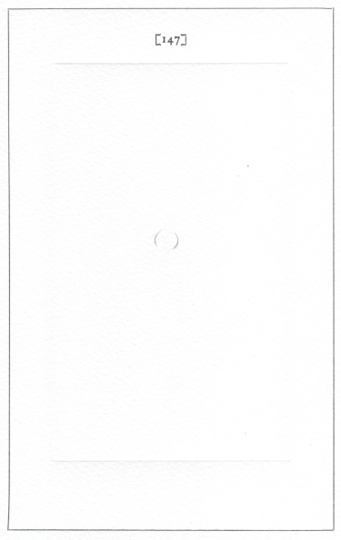
Many of the works demonstrate a similar ambition, with work #135 perhaps the most extreme example — a concertina’d cascade of paper with quotations relating to the female form from a variety of authors. The work breaches not only the defined blank space but also its boundaries.
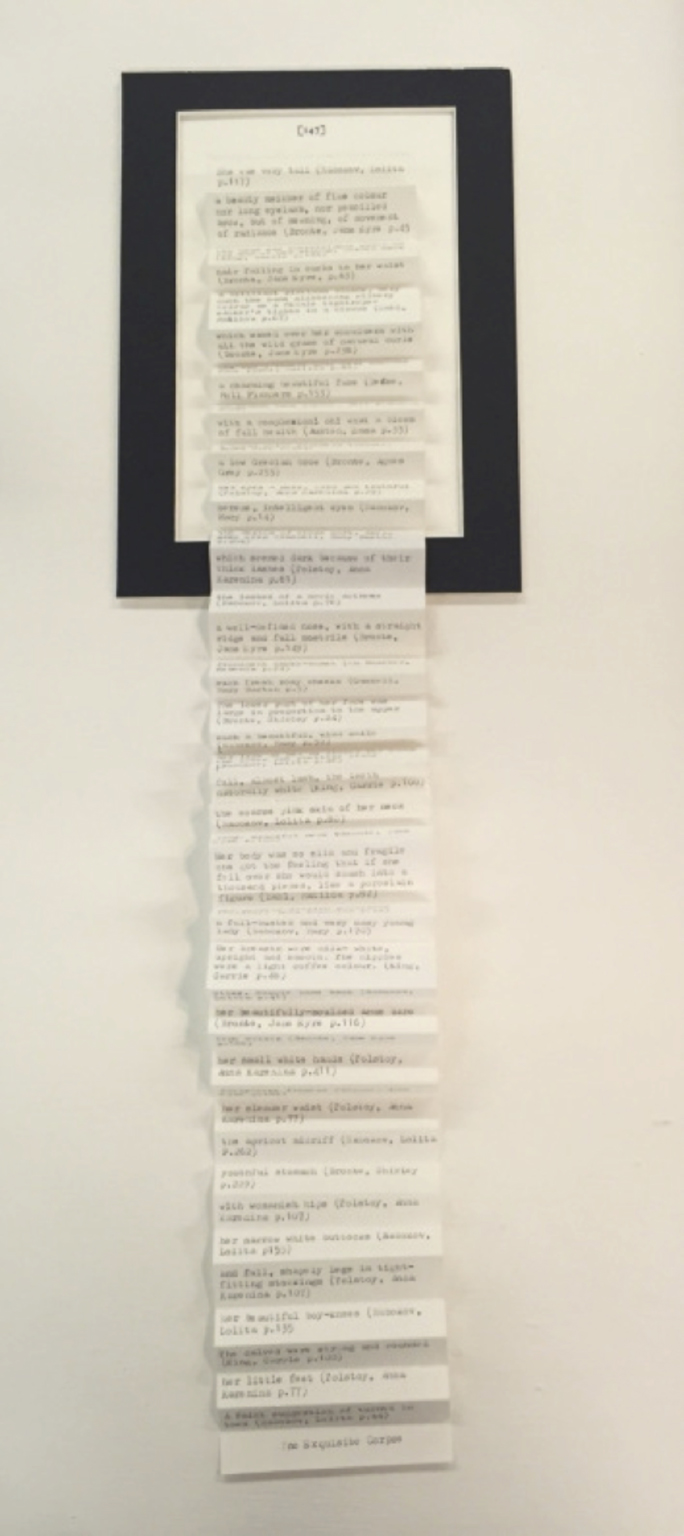
Similarly, work #130 has an Apple iPod nano mounted on the page, with headphones attached, offering a song composed specially for the project.
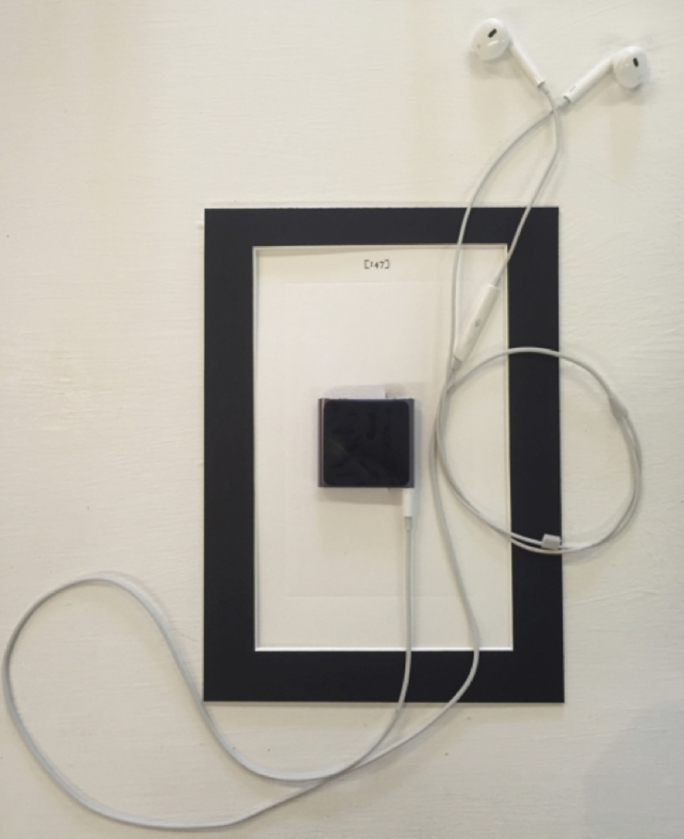
Moving on to consider those works that focus on ideas of beauty we find, unsurprisingly, a number of what might be termed ‘conventional’, ‘classic’ or in some sense idealised beauties, including film stars. Such responses to the brief are appropriate in an age when ‘beauty’ is so often defined in terms of the repeated images of celebrities, and when almost everyone’s ‘own mind’ is populated with imagery from the mass media and internet, whether we like it or not. For example, work #42 consists of a ‘Xerox of a still from the 1961 film Madame Sans-Gene, directed by Christian-Jaque, with Sofia Loren in the title role’. The artist writes:
This is rather prosaic, I know, as a ‘painting’. But, ever since I was 10, this image comes to my mind if I associate the 18th century and the word ‘concupiscible’, used by Sterne for Widow Wadman. The action of this film takes place in 1789, only 21 years later than the last volume of Tristram Shandy was published, so no huge anachronism here.
Thus we see an apparently banal response nevertheless inflected with interesting logic. If the image, in being so specific — and already so invested with various associations and meanings within our culture — does not allow for a great deal of further contemplative interpretation by the viewer, it nevertheless raises questions about how the contemporary world may understand ‘beauty’ or that little-used word, ‘concupiscible’, at all.
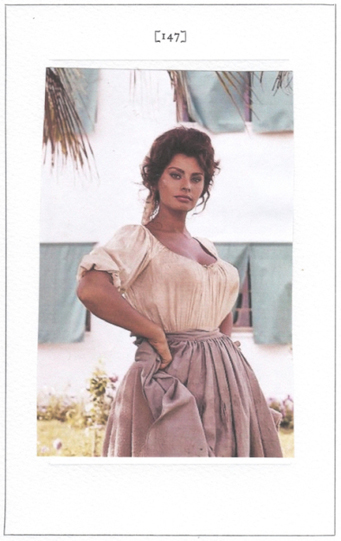
Other works make reference to images by or of a variety of artists and writers, including Sappho, Eisho and Modligiani, further emphasising the intertextual nature of contemporary artistic culture, and the ways in which ideas are now so often transmitted through the reproduction of images.
Some of the more ‘personal’ artworks are anything but conventional. Work #78, described simply as ‘Lady in Red’, is an example, presenting as it does a humorous and subversive interpretation of the brief.
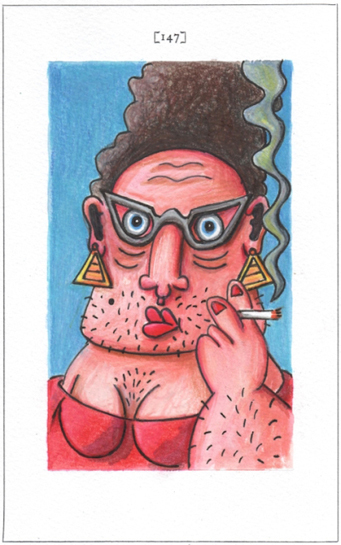
This image represents a critique of the concept of objectifying and constructing female ‘beauty’. Whereas Sophia Loren represents a conventionally acceptable idea of the beautiful, ‘Lady in Red’ asks fairly directly why we make such images and what, in a broader sense, they represent.
3. Mirroring
One image repeated several times among the works is the mirror, an example of which (again with solid material presence) is work #107. Other works make use of reversed (or mirrored) text. Although such an artistic strategy may seem unexpected, it plays nicely with the concept that the reader/artist is looking inwards in order to ‘paint her to your own mind’. Such works also question whether, in the avowedly narcissistic twenty-first century, people find their image of beauty primarily in themselves. And an associated idea might also be that in reading a work, a viewer does — at least to some extent — see themselves in it. Additionally, images of mirrors grapple in interesting ways with the concept of portraying or populating the blank page because a mirror is simultaneously blank and filled with a (reflected) image.
All of these ideas relate to the multiplicity of Sterne’s original gesture, and are evidence for its myriad implications. Further, and bearing in mind that many women are project participants, images of mirrors may be interpreted as indicating a feminist position: that the objectification of women is undesirable; that, in any case, the construction of art and identity when making images depends on an unstable interplay between viewer, artist and work; or even that Sterne’s gesture may be somewhat quizzically reflected back on itself.
Two further works are notable for their explicit reiteration in contemporary terms of Sterne’s original invitation. Work #105 offers a paint chart — suggesting that the work remains for the viewer to complete — and work #59 presents a Photoshop window and a camera disk.
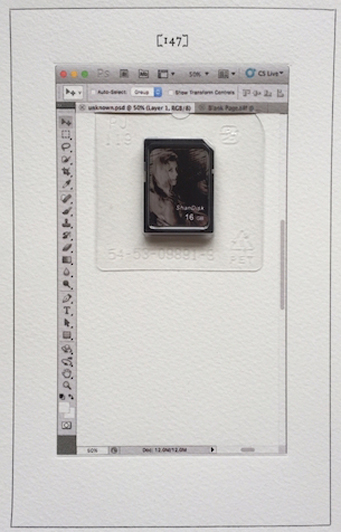
The accompanying text reads:
This blank page, for all its visual accoutrements, remains blank, so that Sterne’s invitation to ‘paint her to your own mind’ is extended to the future reader/owner. The Photoshop window, with painting toolbox at the ready, has two files open, but the chosen one is obscured by the ‘unknown’, an image overexposed to the point of emptiness. The space is occupied instead by a camera card hanging like a miniature portrait. This ‘ShanDisk’, labeled using an image seemingly from a vintage glamour magazine (and whether or not currently blank) gives scope for endless further portraiture.
These words defer any straightforward realisation of Sterne’s direction to his readers and highlight how the relationship between author/artist, text and reader/viewer that so preoccupies Sterne in Tristram Shandy remains a highly fruitful trope in the current century. Digital technologies and the internet make imagery of all kinds readily available and able to be manipulated, and ‘painting’ now takes place in wide variety of digital spaces as well as on the page.
4. A third dimension
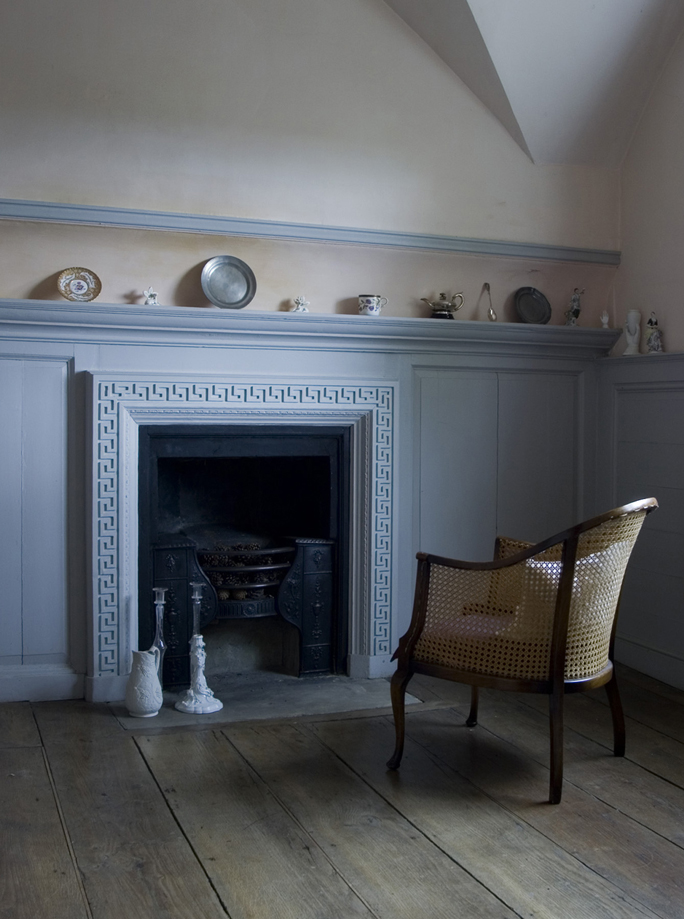
Sterne’s amused and ironic invitation to the reader also questions conventional notions of morality — both as they pertained in Sterne’s time and now. Knowing what we do of Sterne, the casual and ironic handling of the wife-mistress axis is not entirely surprising. Sterne, a married vicar, had a deeply-imagined fantasy relationship with Eliza Draper, a woman married to another man. The relationship is chronicled in the Journal to Eliza (1767), published after his death, in which Sterne writes, ‘I have this week finish’d a sweet little apartment which all the time it was doing, I flatter’d the most delicious of Ideas, in thinking I was making it for you’. The room is no fantasy; it is a space that Sterne prepared and maintained for no other purpose. Even today, ‘Eliza’s room’ is undisturbed, preserving the fantasy that so occupied Sterne when he was alive. It is not open to the public.
Within the context of Tristram Shandy, part of the humour in Sterne’s invocation of the well-worn trope of wife versus mistress rests on the assumption that the reader may indeed have such a combination of similar figures in his or her life, or may at least wish that they did. Sterne (or his narrator) sensibly distances himself from any judgement about such matters: ‘‘tis all one to me’. Different readers of both genders will react differently to these matters: some will, like Sterne, be amused; others may be unimpressed.
As our discussion has indicated, some artists responded by playfully subverting or recasting the terms of the assignment — very much in the spirit that Sterne brought to his own compositions. However, in viewing all of the commissioned works, ambivalence towards the brief is not evident in many of them, although there is a sense that many reveal only a part of their meaning. Only the artists are privileged to have all the information that informs their imagery and, in this sense, the project is faithful to its driving concept — the ‘truth’ of each image is indeed painted only to the artist’s own mind.
Work #59 plays on this idea, specifically addressing the viewer’s (possible) wish to get inside the artist’s secret mind. In presenting a camera disk as part of the work, it invites the belief that further evidence is there to be discovered — only available, of course, to the purchaser should he or she choose to dismantle the work. The artist has created a further level of play, making the auction a conceptual dimension of the work itself. We don’t know if a further revelation actually awaits the purchaser; if not, there is the reward of a functional blank disk, for use in further image-making.
5. Conclusion
Laurence Sterne’s Tristram Shandy remains an endlessly suggestive work, capable of galvanising new creative projects and inspiring new artists across a wide variety of media. Sterne’s early novel not only laid an important part of the ground for the development of future fiction in a variety of languages — an influence that continues to this day — but it seems newly relevant to a world where so much creative practice understands uncertainty, indeterminacy, intertextuality and the active role of the reader in making meaning.
To a significant extent, in some of its key techniques Sterne’s novel may be seen to foreshadow the development of interactive fiction and the use of hypertext. If Sterne were writing today, the Internet would provide him with various tools and options to make Tristram Shandy an even more sprawling, various, unconventional and uncontainable work than it already is. The ‘Paint her to your own mind’ project includes works by composers (David Owen Norris and Craig Vear) as well as writers and visual artists. The idea of a silent music interwoven into some of the works is a beguiling one, and adds a further dimension to ways of perceiving and understanding the project’s works — a blank page, a silent music, a way of thinking beyond the twenty-first century’s relentless noisiness.
Overall, the many contributions have become a kind of conversation that faces a number of different ways, and gestures towards a wide variety of understandings. Every work faces Tristram Shandy, either squarely or slantwise; each of the works speaks to the others; and each is part of a larger conversation about contemporaneity and the continuing relevance of past masterworks. There is also a continuing conversation between readers and viewers of the project works, and of Sterne’s novel. These conversations reach widely, and this article is simply one aspect of them, exploring some of what Sterne and modernity have to say to one another.
Notes
1 The full collection of 147 works and their accompanying information can be found at: https://blankpage147.wordpress.com. All the works remain anonymous, but a full list of participating artists is supplied.
2 The Black Page project asked for 73 individual representations of black, something of a conundrum; the Emblem project asked for a response to Sterne that was equally a stamp of individuality.
3 Each artist was invited to provide information about materials used (as with any displayed or catalogued visual art) but also any other information.
Day, G 2016 ‘The Blank Page’, https://blankpage147.wordpress.com/the-blank-page (accessed 27 November 2017)
The Laurence Sterne Trust 2016 ‘The Blank Page’, https://blankpage147.wordpress.com/the-blank-page (accessed 27 November 2017)
Munden, P 2011 Asterisk, Sheffield: Smith|Doorstop
Munden, P 2016 ‘The Black Page’, Axon: Creative Explorations, C1
Munden, P 2017 Chromatic, Perth: UWA Publishing
Munden, P and F Edmonds-Dobrijevich 2018 ‘The Marbled Page—“Motly Emblem of My Work”: Laurence Sterne and Multimodal Literacy’, The International Journal of Arts Theory and History 13.1: 17-30. doi:10.18848/2326-9952/CGP/v13i01/17-30
Sterne, L 1767 The Life and Opinions of Tristram Shandy, Gentleman in I Campbell Ross (1998) (ed) Laurence Sterne, The Life and Opinions of Tristram Shandy, Gentleman, Oxford: Oxford University Press
Sterne, L 1767 Journal to Eliza in I Jack and T Parnell (2003) (eds) Laurence Sterne, A Sentimental Journey and Other Writings, Oxford: Oxford University Press